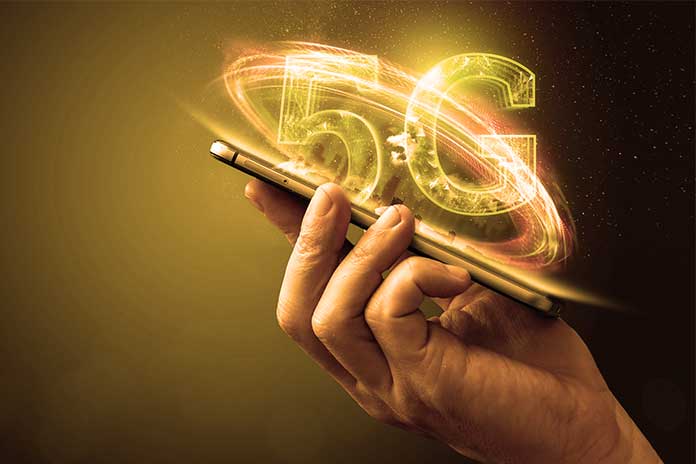The fifth generation of mobile communications, 5G for short, enjoys uninterrupted interest like hardly any other tech topic. There seems to be no way around the LTE successor when it comes to connectivity. But what is the fastest mobile network to date capable of, who benefits, and what about security? 5G, i.e., the fifth generation of mobile communications, should enable many mobile applications in which low latency is essential. With 5G, enabling technology is coming onto the market, making it possible to significantly advance digitization in core sectors such as manufacturing, automotive, and energy.
By merging the telecommunications industry with major industry players and partners, the new mobile communications standard creates the conditions for raising connectivity to a whole new level. 5G has the potential to revolutionize areas such as logistics and industry, mobility, and the health sector – whether as part of the Internet of Things or directly through campus networks. One thing may be clear: 5G will be a new mobile communications standard and the new basis for digital innovations across all industries. But what exactly can the “miracle weapon” 5Goffer do?
The Advantages Of 5G At A Glance
Speed
5G networks mean, above all: higher speed. Compared to 4G/LTE, 5G has a 100 times higher data rate or 1,000 times higher capacity. Downloading files, for example, is much faster.
Networking
5G technology is ideal for connecting digital end devices thanks to its high capacity. This means that it allows a significantly higher density of networked devices: 5G supports up to one million devices per square kilometer.
Latency
5G enables data transmission in real-time. It depends on the latency: the lower it is, the faster the applications. With 5G technology, latencies in the millisecond range are possible. As soon as this low latency level is reached, completely new possibilities for interaction open up, especially in augmented reality, virtual reality, mixed reality, autonomous driving, and robotics.
Connection Security
There are applications in which a high level of connection security is fundamental, such as autonomous driving or telemedicine. Associated devices or sensors must be able to communicate with each other securely. This is made possible by many antennas, which are also involved in data transmission.
Energy Consumption
New 5G-enabled devices and sensors have an unbeatable advantage: their energy consumption is a full 90 percent lower than that of their predecessors. This is because they require fewer resources. They are also smaller and have a significantly longer battery life. There are already sensors on the market that can last ten years without changing the battery.
5G And IoT – Ideal Composition?
More networking among each other, data transmission in real-time, higher connection security – all these properties of the 5G network offer enormous potential for a wide variety of industries – and thus also for the IoT area. The Internet of Things is playing an increasingly important role in society, which will continue to manifest itself with the introduction of the nationwide 5G network. In short, IoT means that intelligent devices communicate independently with each other. This requires real-time data transmission.
Simple options such as networking blinds and lamps in smart homes already exist in the 4G network. However, more complicated functions beyond privately used parts automatically ensure higher data traffic. So it becomes clear: when one speaks of IoT, it is not about the individual devices themselves but rather about their connectivity, i.e., the big picture. Because the unique applications and devices must communicate with each other smoothly. 5G technology can provide all the necessary prerequisites for this.
Which Industries Will Benefit From 5G?
Telecommunications, industry, consumer goods: these and many other sectors will be optimized by 5G technology. Data transmission in real-time plays a role in technical areas such as mobility and is also relevant for the healthcare sector. It will be a milestone for the safety of autonomous driving if, for example, self-driving cars can communicate with networked traffic lights in real-time. Any delay here can be life-threatening.
The same applies to e-health, where data transmission can ensure that patients’ vital signs are sent directly from the ambulance to the relevant hospital. New avenues are also opening up for industrial production: Because 5G networks are designed with a massive capacity of up to 500 billion devices, the number of interconnected devices per cell can increase to hundreds of thousands. This density of end devices to be reached ensures that production facilities and processes can be designed differently.
Low latency and connection security also play essential roles in automating production processes. The direct impact on consumers will also become apparent, for example, in smart cities. Smart Parking can be found and reserved in advance using an app. Street lamps are becoming all-around talents: they adapt their light to the number of people and measure traffic jams, serve as WiFi hotspots, and are charging stations for electric vehicles.
5G And Cybersecurity
So 5G creates countless new opportunities and unknown security risks in all these industries because consumers and companies are increasingly acting and working with interconnected, digital applications. The possible points of attack increase to an innumerable number due to the increased networking, which makes the entire ecosystem more vulnerable to cyber-attacks. Mobile operators should, therefore, work towards building an economy based on 5G technology and ensure that it is adequately protected against external attacks.
This includes the security of the applications and data in the network and the data centers, branch offices, and the cloud—a big challenge. So we are expecting a lot from 5G – an optimized, private use of the Internet, but above all, a leap in the economy, driven by the technology related to the IoT, for which 5G will play a key role. Everything should become faster, more efficient, and more energy-efficient. A groundbreaking development, but one should not neglect the security standards that have to grow at the same level to protect the “new network” accordingly.

